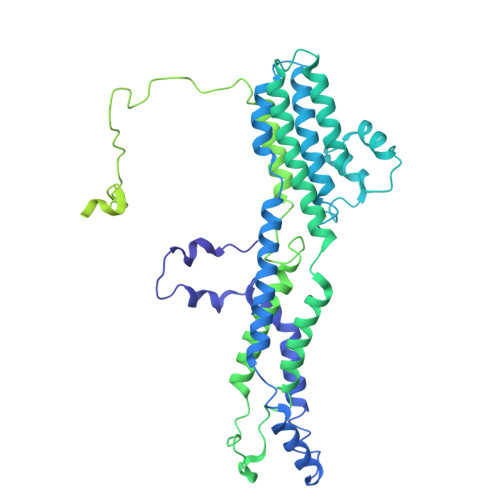Cryo-EM structures of mouse bestrophin 1 channel in closed and partially open conformations.
Kim, K.W., Lee, E., Ko, A., Hwang, J., Park, K., Lee, B.C., Kim, K.W., Oh, W.J., Kim, K., Lim, H.H.(2025) Mol Cells 48: 100208-100208
- PubMed: 40043778
- DOI: https://doi.org/10.1016/j.mocell.2025.100208
- Primary Citation of Related Structures:
9KC9, 9KCA, 9KP6 - PubMed Abstract:
Bestrophin-1 (BEST1) channels are calcium-activated Cl - channels involved in diverse physiological processes, including gliotransmitter release in astrocytes. Although human and chicken BEST1 orthologs have been extensively studied, the structural and functional properties of mouse BEST1 (mBEST1) remain poorly understood. In this study, we characterized the structure-function of mBEST1-BF, a C-terminally tagged variant, using whole-cell patch-clamp recordings, surface biotinylation assays, and single-particle cryo-electron microscopy (cryo-EM). Cryo-EM structural analysis of mBEST1-BF revealed closed and partially open conformations. Comparative analysis with human and chicken BEST1 orthologs highlighted conserved calcium-binding and gating mechanisms, with distinct features in mBEST1, including a wider aperture sufficient to accommodate dehydrated Cl - ions and potential anion-binding sites near Val205 and Gln208 residues. The disordered C-terminal region of mBEST1 remains unresolved, suggesting it may require stabilizing factors for structural determination. Additionally, the autoinhibitory domain, which includes Ser354, likely plays a key role in regulating gating, with Ser354 potentially serving as a phosphorylation site that modulates channel activity. Our findings provide structural and functional insights into mBEST1 and suggest mechanisms underlying its unique gating and ion permeation properties.
- Neurovascular Unit Research Group, Korea Brain Research Institute (KBRI), Daegu, 41068, Republic of Korea.
Organizational Affiliation:


















